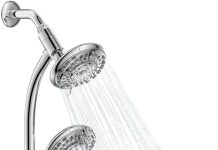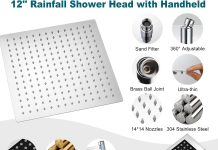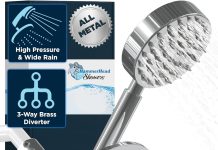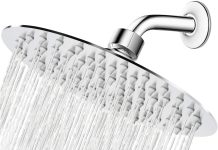Have you ever installed a new shower head, only to find that the water pressure is disappointingly low? It can be frustrating and leave you longing for a revitalizing shower experience. But fear not, for we have the answer to this seemingly perplexing question. In this article, we will explore the reasons behind why your brand-new shower head might have low pressure, providing you with a clear understanding of what’s causing the issue and how you can resolve it. So, let’s uncover the mystery and restore the invigorating power to your shower!
Table of Contents
Possible Causes of Low Pressure in a New Shower Head
When we install a new shower head, we expect a refreshing and invigorating shower experience. However, it can be quite frustrating to find that the water pressure is disappointingly low. Several factors can contribute to this issue, and in this article, we will explore the possible causes of low pressure in a new shower head and how to troubleshoot each one effectively.
Restricted Flow Rate
One common cause of low pressure in a new shower head is a restricted flow rate. Many shower heads are designed with flow restrictors or aerators to conserve water and comply with water efficiency regulations. While these devices may be beneficial for the environment and your utility bills, they can sometimes hinder the optimal water flow.
Flow Restrictor
A flow restrictor is a small, disk-shaped component that limits the amount of water that passes through the shower head. It is usually located in the shower head’s inlet or inside the handle. If the flow restrictor is too restrictive, it can significantly reduce the water pressure, resulting in a weak shower experience.
To address this issue, you can try removing the flow restrictor from the shower head. This can be done by unscrewing the shower head from the shower arm, locating the restrictor, and gently pulling it out. Be cautious not to damage any other components during the process. Once removed, reattach the shower head and test if the water pressure has improved.
Aerator
Similar to a flow restrictor, an aerator is another device that controls water flow. It disperses the water into small, concentrated streams and mixes it with air to create a pleasing shower experience. However, if the shower head’s aerator becomes clogged or dirty, it can restrict water flow, resulting in low pressure.
To clean the aerator, remove the shower head from the shower arm and locate the aerator usually positioned at the end of the shower head. Gently unscrew the aerator and rinse it under running water to remove any debris or mineral buildup. Once cleaned, reattach the aerator and test the water pressure.
Clogged Shower Head
Another potential cause of low pressure in a new shower head is a clogged shower head. Over time, minerals from hard water, soap residue, and even hair can accumulate inside the shower head, obstructing the flow of water and decreasing the pressure.
Hard Water Deposits
If you live in an area with hard water, characterized by a high mineral content, it is common for mineral deposits to build up inside the shower head. These deposits, often composed of calcium and magnesium, can clog the nozzle openings and restrict water flow.
To address this issue, remove the shower head from the shower arm and immerse it in a solution of vinegar and water. Let it soak for about 30 minutes to an hour, allowing the vinegar to dissolve the mineral deposits. After soaking, scrub the shower head gently with a brush to remove any remaining residue. Rinse the shower head thoroughly with water before reinstalling it.
Mineral Buildup
Even in areas with relatively soft water, mineral buildup can still occur over time. The minerals present in the water can accumulate within the shower head, obstructing the flow and reducing the water pressure.
Cleaning the shower head using the vinegar and water solution mentioned earlier should help remove any mineral buildup. However, if the buildup is extensive and stubborn, you may consider using a lime scale remover specifically designed for shower heads. Follow the instructions on the product carefully and rinse the shower head thoroughly before reattaching it.
Hair and Soap Residue
Apart from minerals, hair and soap residue can also contribute to clogged shower heads. These substances can accumulate over time, particularly if proper cleaning and maintenance are neglected.
To clear the clog caused by hair and soap residue, remove the shower head and inspect the nozzle openings. Use a small brush or a toothpick to gently dislodge the debris from the openings. Once cleared, rinse the shower head thoroughly and reinstall it.
Water Pressure Regulator Issue
A malfunctioning water pressure regulator can also lead to low pressure in a new shower head. The regulator controls the water pressure entering your home and ensures that it remains within a safe and optimal range. If the regulator is faulty or incorrectly set, it can result in inadequate pressure in your shower.
Faulty Regulator
A faulty water pressure regulator may not be allowing enough water pressure to reach your shower head. If you suspect this to be the cause, it is best to seek professional help to inspect and replace the regulator if necessary. A licensed plumber can accurately diagnose the issue and recommend the appropriate solution.
Incorrectly Set Regulator
In some cases, the water pressure regulator may be set too low, limiting the pressure in your shower. While adjusting the regulator requires expertise, you can attempt to increase the pressure slightly by turning the regulator clockwise. Be cautious not to adjust the pressure too high, as it may lead to other problems such as leaks or burst pipes. If you are uncertain or uncomfortable making adjustments, consult a professional plumber for guidance.
Plumbing Blockages
Blockages in your plumbing system can significantly impact water flow and result in low pressure in your shower head. Various factors can cause these blockages, and identifying the specific location of the obstruction can aid in resolving the issue.
Pipe Blockages
Over time, debris, sediment, or even rust can accumulate in the pipes, impeding the smooth flow of water. These blockages can occur in different sections of the plumbing system, including the pipes leading to your shower.
If you suspect a pipe blockage, it is advisable to consult a professional plumber for a thorough assessment. They will have the necessary tools and expertise to locate and clear any blockages, restoring adequate water pressure.
Partially Closed Isolation Valves
Isolation valves are often located near fixtures such as showers, sinks, or toilets. These valves allow you to shut off the water supply to specific areas without affecting the rest of the plumbing system. In some cases, these valves may not be fully open, restricting water flow and resulting in low pressure.
Take a moment to check if the isolation valve near your shower is fully open. Turn the valve counterclockwise to ensure it is in the fully open position. If the valve was partially closed, reopening it should restore the water flow and improve the pressure in your shower.
Obstructed Water Supply Lines
Blockages can also occur in the main water supply lines leading to your home. These obstructions can vary in size and composition, ranging from tree roots to sediment buildup. If the obstruction is significant, it can impact the water pressure throughout your entire home, including your shower.
If you suspect an obstruction in the water supply lines, it is essential to contact your water service provider or a professional plumber. They will be able to identify the location of the blockage and take appropriate measures to clear it, restoring the water pressure in your shower.
Faulty Shower Valve or Diverter
A faulty shower valve or diverter can also contribute to low pressure in your new shower head. The shower valve controls the flow and temperature of the water, while the diverter directs the water between different fixtures such as the showerhead, bathtub faucet, or hand shower.
Incompatible Valve or Diverter
If you have recently replaced the shower head and are experiencing low pressure, it is possible that the new shower head is incompatible with your existing valve or diverter. Different fixtures may have different flow rates and requirements, and using a shower head that does not match the capabilities of your valve or diverter can result in reduced pressure.
To address this issue, consult with a professional plumber or the manufacturer of your shower head to ensure compatibility. They will be able to recommend suitable options or suggest adjustments to optimize the water pressure.
Worn-Out Valve or Diverter
Over time, shower valves and diverters can wear out or develop internal leaks, leading to reduced water pressure. If your shower head has recently experienced a significant decrease in pressure, it is worth checking the condition of your valve or diverter.
Inspect the valve or diverter for any signs of wear, corrosion, or leakage. If you notice any issues, it is best to consult with a professional plumber to evaluate the situation. They will be able to determine if the valve or diverter needs repair or replacement, restoring optimal water pressure in your shower.
Air in the Water Line
Air trapped in the water line can also result in low pressure in your new shower head. This issue is commonly associated with the initial installation of a shower head or changes in the plumbing system.
Air Trapped in the Pipes
During the installation of a new shower head or any modifications to your plumbing system, air can become trapped in the pipes. This trapped air displaces the water, leading to reduced pressure and possibly inconsistent water flow.
To release the trapped air, turn on the shower to its highest setting and allow it to run for a few minutes. The continuous flow of water can help displace the air pockets, resulting in improved pressure. If the issue persists, it is advisable to consult with a professional plumber for further evaluation.
Air Vacuum in the Water Heater
Another potential cause of air in the water line is an air vacuum in the water heater. If the water heater is not functioning correctly or has an issue with the air vent or pressure relief valve, it can create a vacuum that pulls in air from the surrounding environment. This air can then enter the water lines, affecting the pressure in your shower.
If you suspect an air vacuum in the water heater, it is best to contact a professional plumber to inspect and address the issue. They will have the knowledge and expertise to diagnose the problem accurately and recommend the necessary repairs or adjustments.
Inadequate Water Supply
Sometimes, the cause of low pressure in your new shower head may not be attributed solely to the shower head or plumbing system itself. Inadequate water supply can also contribute to reduced pressure, leaving you with a lackluster shower experience.
Insufficient Water Pressure
Insufficient water pressure from your municipal water supply can limit the pressure in your shower head. This can occur if your area has low water pressure or if there is high demand during peak usage periods.
To determine if this is the cause, you can contact your local water service provider and inquire about the water pressure in your area. If low pressure is a common issue, you may need to explore alternative solutions such as installing a booster pump to enhance the pressure.
Undersized Water Supply Pipes
The size of the water supply pipes in your home can also impact the water pressure. If the pipes leading to your shower are undersized, they may not be able to deliver an adequate amount of water to maintain optimal pressure.
If you suspect that your water supply pipes are undersized, it is advisable to consult a professional plumber. They will be able to assess your plumbing system and recommend appropriate solutions, such as increasing the pipe diameter, to improve the water pressure in your shower.
Municipal Water Pressure Fluctuations
The water pressure from your municipal supply can fluctuate due to various factors, impacting the pressure in your new shower head. These fluctuations can occur temporarily and affect the water pressure throughout your entire home, including your shower.
Peak Usage Periods
During peak usage periods, such as early mornings or evenings when many residents are using water simultaneously, the demand on the municipal water supply may exceed its capacity. This increased demand can result in decreased water pressure, affecting your shower experience.
While you may not have control over peak usage periods, try adjusting your shower schedule to times when water demand is lower. This may help ensure that you have adequate water pressure for a satisfying shower.
Water Main Maintenance or Repairs
Periodic maintenance or repairs on the water mains in your area can also lead to temporary water pressure fluctuations. When the water provider performs maintenance work or repairs on the main water lines, the pressure can be intentionally reduced or disrupted, resulting in low pressure in your shower.
If you suspect that maintenance or repairs are causing the low pressure issue, contact your water service provider for information. They should be able to provide an estimated duration for the work and advise you on any necessary precautions or alternative water sources during that time.
Incorrect Shower Head Type
An often overlooked cause of low pressure in a new shower head is using an incompatible shower head type for your water pressure situation. Different types of shower heads have varying flow rates and are designed to function optimally within specific pressure ranges.
High Flow Shower Head in Low Pressure Area
If you have low water pressure, using a high flow shower head designed for higher pressure can result in disappointing performance. The shower head may require more pressure than your system can provide, leading to reduced flow and poor pressure.
To address this issue, consider replacing your high flow shower head with a low flow or water-saving shower head designed to operate effectively even in low-pressure situations. These shower heads are specifically designed to provide a satisfying shower experience while conserving water.
Low Flow Shower Head in High Pressure Area
Conversely, using a low flow shower head in an area with high water pressure can also result in inadequate pressure and a lackluster shower experience. Low flow shower heads are designed to restrict water flow to conserve water, but they may not be suitable for areas with abundant pressure.
If you have high water pressure, consider switching to a shower head with a higher flow rate to match your water pressure capabilities. This should help optimize the pressure and provide a more satisfying shower experience.
In conclusion, there are numerous possible causes of low pressure in a new shower head. By understanding these potential issues and following the troubleshooting steps outlined above, you can identify and address the specific cause affecting your shower. Whether it’s a restricted flow rate, clogged shower head, water pressure regulator issue, plumbing blockages, faulty shower valve or diverter, air in the water line, inadequate water supply, municipal water pressure fluctuations, incorrect installation, or using an incompatible shower head type, taking the appropriate measures can help restore optimal water pressure and ensure a rejuvenating shower experience.






















